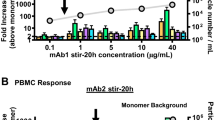Abstract
Existence of autocrine growth factors (aGFs) may influence the serum requirement for growth of hybridoma cells and thus significantly influence process economics. For the murine hybridoma cell line S3H5/γ2bA2, critical inoculum density (cID) and serum requirement for growth were inversely related for cultivation in both T flasks and spinner flasks. In spinner flasks, an inoculum density of 106 cells/ml was necessary for the cells to grow in RPMI 1640 medium without serum supplement, and an inoculum density of 103 cell/ml was necessary in RPMI 1640 medium with 10% serum. In T flasks, where the local cell density is higher than in spinner flasks, an inoculum density of 106 cells/ml was necessary for the cells to grow in RPMI 1640 medium without serum supplement, and an inoculum density of 1 cell/ml was also necessary in RPMI 1640 medium with 10% serum. Further, immobilized cells at high local cell density could grow under conditions where cells in T flasks at corresponding overall cell density could not grow. The cells at high inoculum density were less sensitive to shear induced by mechanical agitation than the cells at low inoculum density. Taken together these observations support the existence of secreted aGF(s) by the hybridoma cell line used. Since the specific MAb production rate was independent of cultivation method and inoculum density, the existence of autocrine growth factors would suggest that the use of immobilized cells should improve the economics of MAb production.
Similar content being viewed by others
References
Balkwill, F. R.Cytokines in Cancer Therapy. Oxford University Press: Oxford, 1989; pp. 174–181.
Bergman, Y.; Haimovich, J.Eur. J. Immunol. 1977, 7, 413–417.
Cooper, G. M.Oncogenes. Jones and Bartlett Publishers, Inc.: Boston, MA, 1990; pp 163–173.
Dean, Jr., R. C.; Karkare, S. B.; Ray, N. G.; Rundstadier, Jr., P. W.; Venkatasubramanian, K.Ann. N. Y. Acad. Sci.,1987, 506, 129–146.
Dodge, T. C.; Hu, W. S.Biotechnol. Lett. 1986, 8, 683–686.
Hagedorn, J.; Kargi, F.Biotechnol. Prog.,1990, 6, 220–224.
Heath, C.; Dilwith, R.; Belfort, G.J. Biotechnol. 1990, 15, 71–90.
Hirano, T.; Yasukawa, K.; Harada, H.; Taga, T.; Watanabe, Y.; Matsuda, T.; Kashiwamura, S.; Nakajima, K.; Koyama, K.; Iwamatsu, A.; Tsunasawa, S.; Sakiyama, F.; Matsui, H.; Takahara, Y.; Taniguchi, T.; Kishimoto, T.Nature. 1986, 324, 73–76.
Kiwano, M.; Hirano, T.; Matsuda, T.; Taga, T.; Horii, Y.; Iwato, K.; Asaoku, H.; Tang, B.; Tanabe, O.; Tanaka, H.; Kuramoto, A.; Kishimoto, T.Nature. 1988, 332, 83–85.
Kunas, K. T.; Papoutsakis, E. T.;Biotechnol. Lett. 1989, 11, 525–530.
Kunas, K. T.; Papoutsakis, E. T.J. Biotechnol.,1990, 15, 57–69.
Lee, G. M.; Huard, T. K.; Palsson, B. O.Biotechnol. Lett. 1988, 10, 307–312.
Lee, G. M.; Huard, T. K.; Kaminski, M. S.; Palsson, B. O.Biotechnol. Lett. 1988, 10, 625–628.
Lee, G. M.; Huard, T. K.; Palsson, B. O.Hybridoma 1989, 8, 369–375.
Lee, G. M.; Savinell, J. M.; Palsson, B. O.Hybridoma 1989, 8, 639–645.
Lee, G. M.; Palsson, B. O.Biotechnol. Technique 1990, 4, 341–344.
Lee, G. M.; Palsson, B. O.Biotechnol. Bioeng. 1990, 36, 1049–1055.
Maiorella, B.; Howarth, B.; Shauger, A.; Inlow, D. Optimized pH control for antibody production. Presented at ACS National Meeting, Miami, FL, 1989.
McQueen, A.; Bailey, J. E.Biotechnol. Lett.,1989, 11, 531–536.
Murakami, H.; Masui, H.; Sato, G. Suspension culture of hybridoma cells in serum-free medium: soybean phospholipids as essential components. InGrowth of Cells Hormonally Defined Media; G. Sato, A. Pardee, D. Sinbasku, Eds.: Cold Spring Harbour Laboratories, Cold Spring Harbour: New York, 1982; pp 711–715.
Petersen, J. F.; McIntyre, L. V.; Papoutsakis, E. T.J. Biotechnol. 1988, 7, 229–246.
Pol, L.; Zijlstra, G.; Thalen, M.; Tramper, J.Bioprocess Engr.,1990, 5, 241–245.
Ozturk, S. S.; Palsson, B. O.J. Biotechnol. 1990, 16, 259–278.
Reuveny, S.; Velez, D.; Miller, L.; MacMillan, J. D.J. Immunol. Methods,1986, 86, 61–69.
Sakai, K.; Hattori, T.; Matsuoka, M.; Asou, N.; Yamamoto, S.; Sagawa, K.; Takatsuki, K.J. Exp. Med. 1987, 166, 1597–1602.
Shacter, E.Trends Biotechnol.,1989, 7, 248–253.
Sporn, M. B.; Roberts, A. B.Nature 1985, 313, 745–747.
Tharakan, J. P.; Chau, P. C.Biotechnol. Lett. 1986, 8, 457–462.
Velez, D.; Reuveny, S.; Miller, L.; Macmillan, J. D.J. Immunol. Methods 1986, 86, 45–52.
Author information
Authors and Affiliations
Rights and permissions
About this article
Cite this article
Lee, G.M., Kaminski, M.S. & Palsson, B.O. Observations consistent with autocrine stimulation of hybridoma cell growth and implications for large-scale antibody production. Biotechnol Lett 14, 257–262 (1992). https://doi.org/10.1007/BF01022320
Issue Date:
DOI: https://doi.org/10.1007/BF01022320




